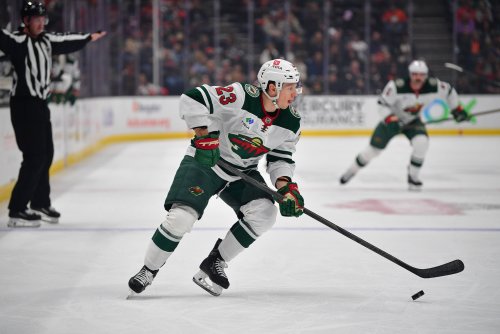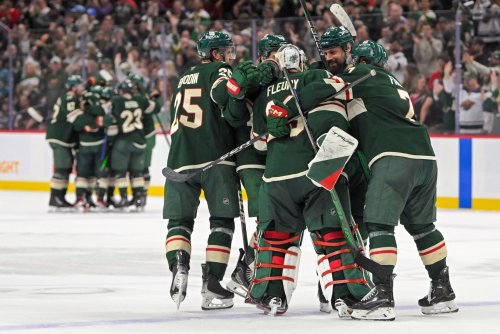
The Minnesota Wild has been considered a top defensive team in the NHL for some time now. Whether through analytics or the eye test, it’s hard to say that the Wild haven’t been built through goaltending and defense. However, the defensive core was disbanded over the offseason with the departure of Ryan Suter and Carson Soucy. The plus side is that they brought in some solid replacements for Suter, and general manager Bill Guerin bolstered the third pair too. For context purposes, these defensemen are the only ones that have at least 50 minutes of time on ice so far this season.
Suter was a critical piece of the puzzle being put together in the State of Hockey. Primarily, he was an assistant captain and viewed as a leader in the locker room. Additionally, his contract suggested that he would be in Minnesota for the rest of his career. Instead, he was bought out and went play on the opposite end of the country with the Dallas Stars. It’s not often we see a 13-year deal signed, but we saw two on July 4, 2012, with both him and Zach Parise, who also departed over the offseason due to a buyout.
Dmitry Kulikov
There was a gaping hole on the top pair, and the team needed a cost-effective option to replace one of their more valuable defensemen. After all, they needed to re-sign their star Russian forward Kirill Kaprizov, which would be costly.
So, how about signing Dmitri Kulikov for two years at $2.25 million AAV? It sounded like a good plan from the outset, and it has paid off. The 31-year-old former first-round draft pick has been around the NHL since 2009. He has never wowed anyone with scoring ability, but his career analytics were decent enough to warrant signing him on a cheap contract. He’s proving to be a very valuable piece.
In terms of analytics rankings through eleven games, Kulikov is second on the team in goals above replacement (GAR) at 2.8, and he’s seventh on the team in expected goals above replacement (xGAR) per Evolving-Hockey. At 5v5, he’s third in expected goals for percentage (xGF%). One might argue that he has been the team’s best defenseman through this first stretch of games.
His Regularized Adjusted Plus-Minus chart (RAPM chart) is about as perfect as it can get. For a player that is most notably a second or third-pairing defenseman, it is extremely impressive that he has put up this kind of numbers. He only has four assists through ten games, but his impact goes far beyond the box score. It’s incredibly encouraging to see this kind of two-way play on the back end.
Jon Merrill
Jon Merrill is another pickup that I and many other fans were extremely pleased with. The luscious locks in his NHL profile picture paired with his play on the ice were perfect for bolstering Minnesota’s defensive depth. He signed a one-year deal worth $850,000, and they’re getting more out of him than that contract might suggest.
Merill has three points through 11 games played, including one goal, and his analytics look excellent as well. He’s right behind Kulikov in GAR in third and falls a little bit down the charts in xGAR to 12th. He’s 11th in xGF%, but he’s still above average at 55.62 percent. Even though he’s playing reasonably sheltered minutes, it’s vital that he performs this well. Having a depth defenseman who can put up these numbers is crucial to building a playoff and, eventually, a Stanley Cup contender.
Both Kulikov and Merrill may be getting some fortunate bounces or just driving play at a higher than expected rate judging by their goals for per 60. However, even with some regression, he will still be one of the best contributors to the overall defensive outcome. I would be less worried about his offensive contributions and more about his defensive ones, which are above average and exactly what you need from him.
The third pairing with him and Kulikov has proven extraordinarily effective and the kind of depth you want. Plenty of teams in the NHL would kill for defensive depth that provides enough offensive firepower and capability to have these kinds of analytics. It’s still a small sample, but there’s a lot to like from those two in particular.
Alex Goligoski
Alex Goligoski has played the least amount of games among these defensemen with eight, and his numbers certainly aren’t at the top of the leaderboard, but he’s still making good on his deal. The 36-year-old veteran defenseman from Grand Rapids, Minnesota, is currently sporting half a point per game with four assists in eight games. Even though his analytics may not suggest he has the most prolific offensive touch, anything the Wild can get in the box score from their defensemen matters.
When he has been in, he’s played on the top pair supporting the captain and one of my favorite defensemen in the NHL, Jared Spurgeon. When he hasn’t been in, Kulikov has taken those duties for the most part. Both players have done well in their role, but I think it would serve the team better to keep Kulikov with Merrill and have Goligoski play more.
Goligoski has a 0.1 GAR and a -0.2 xGAR, and an almost exact 50 percent xGF%. Essentially, he has played around an average level, and I think if you’re head coach Dean Evason, you don’t need anything more. There’s someone on the third pair that can take his duty if it gets out of hand, and he’s there to support Spurgeon. Although point scoring is nice, that isn’t his primary job. Moving the puck decently well and playing strong enough defense is what matters.
I don’t like posting straight-up RAPM charts or analytics all the time (even though I am a proponent of their usage), but I think in this instance, they’re good representations of what’s been happening on the ice. In conjunction with understanding the player’s respective roles on the team, they can be extremely useful. All three of these defensemen have helped the Wild out in some way, shape, or form. It has paid huge dividends to have so many capable defensemen, whether it’s being on the third pairing together or taking shifts on the first pair. We know what Spurgeon, Matt Dumba, and Jonas Brodin can do. It was just a matter of filling in the puzzle pieces. General manager Bill Guerin did that exceptionally well, and in a larger sample size, this will pay off even more than it has already.
Think you could write a story like this? Hockey Wilderness wants you to develop your voice, find an audience, and we'll pay you to do it. Just fill out this form.








Recommended Comments
There are no comments to display.
Join the conversation
You can post now and register later. If you have an account, sign in now to post with your account.
Note: Your post will require moderator approval before it will be visible.